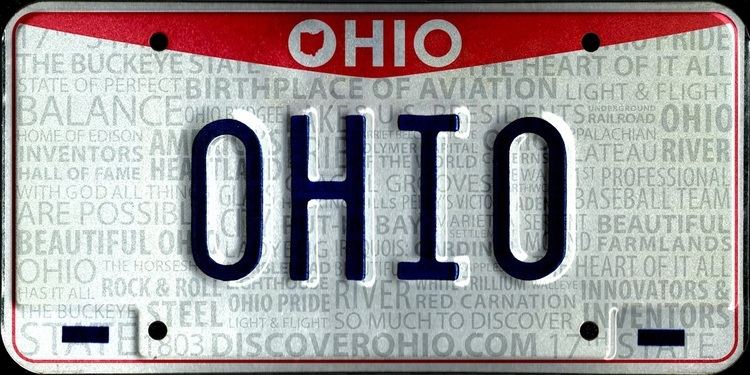Serial format ABC 1234 | Material Galvanized steel | |
 | ||
Slogans Birthplace of Aviation(46 total) Size 12 in × 6 in30 cm × 15 cm Introduced April 15, 2013(3 years ago) (2013-04-15) | ||
License plates are issued in the U.S. state of Ohio for several types of vehicles by the Ohio Bureau of Motor Vehicles, part of the Department of Public Safety. Most types of plates are issued in pairs, to be displayed in the front and rear of the vehicle. They are made of galvanized steel and manufactured by inmates at Ohio Penal Industries at the Lebanon Correctional Institution. The Bureau of Motor Vehicles issues a new license plate design about every five years, or with each new administration in the state government.
Contents
History
On May 19, 1902, Cleveland became one of the first cities in the country to require motorists to display government-issued registration numbers on their vehicles. In the following years, various local governments in Ohio issued standard metal plates of varying design or numerals (to be mounted on a dark background), including:
In 1906, the state attempted to take over auto registration under the Ward Automobile Law, but litigation delayed the program until the Ohio Supreme Court ruled in favor of the law. The Ohio Secretary of State's Automobile Division, precursor to the Bureau of Motor Vehicles, was established in 1907. The Ward Law went into effect on June 11, 1908, but the Automobile Division did not begin issuing plates for another 30 days due to a manufacturing defect. Locally issued and owner-provided license plates were phased out by 1909 for automobiles, but local plates continued to be used for motorcycles until 1914. One effect of the Ward Law was to eliminate a significant revenue stream for cities like Cincinnati, which took in about $5,000 a year (equivalent to $133,000 today) from auto registrations.
Various Ohio license plate designs from 1908 to 1921 used distinctive monograms instead of a fully spelled-out state name.
Passenger number plates were always issued in pairs, with the exception of 1944–1946, during World War II. In 1953, the Bureau of Motor Vehicles issued special pairs of license plates to commemorate the state's sesquicentennial. The back plate listed the years 1803 and 1953, while the front plate bore a special design instead of the license number, with the word "sesqui-centennial" [sic] below. Windshield stickers were issued along with the previous year's plates in 1943 and 1952. A sticker was used to renew the 1974 plates for 1975. Multi-year licence plates, renewable with decal stickers, replaced single-year plates beginning in 1976.
Starting in 1935, a county coding scheme involving the letters in the plate's serial number was introduced. This scheme was used throughout the state until the 1970s, when the system broke down in the most populous counties because of the number of vehicles registered in them. The coding scheme was abandoned with the issuance of the 1980 plates, and long county stickers mounted at the base of the plates were introduced in 1983. Beginning with new specialty plates in 1992 and all new plates in October 2001, the state adopted a county coding scheme on a sticker that displays the county number based on its placement in alphabetical order.
In 1956, the U.S. states and Canadian provinces came to an agreement with the Automobile Manufacturers Association that standardized the size for license plates for vehicles, except those for motorcycles, at 6 inches (150 mm) in height by 12 inches (300 mm) in width, with standardized mounting holes. The 1955 (dated 1956) issue was the first Ohio license plate that complied with these standards.
In 1967, the state began issuing special plates to DUI offenders with limited driving privileges. Judges in Ohio, however, rarely issued them until a 2004 state law made it mandatory for all DUI offenders with limited driving privileges to have them.
Passenger plates 1908 to present
Only plate designs issued since 1996 are currently eligible for use on vehicles.
Non-passenger plates
From 1976 until 1996, license plates for pickup trucks and other light truck-related vehicles (SUVs and conversion vans aside) were issued truck plates that said "Non Comm" (for "non-commercial truck") while semi-trucks were issued plates that said "Commercial". Since 1996, however, the more consumer-oriented truck plates now say "Truck," instead of "Non-Comm."
Temporary tags
Vehicles purchased from a dealership are given a 30-Day Temporary Tag. The paper tag is filled out by hand. Since March 2001, it has featured a hologram.
County coding
Ohio uses a numerical county-coding scheme to indicate the county of registration. The county code is displayed on stickers placed on the lower left corner of both the front and rear plates.
The county number is the most visible, while the full county name is in small print below. The scheme assigns a number to each of the state's eighty-eight counties based on its position alphabetically. For example Adams County, the first alphabetically, is assigned the number 01, and Wyandot County, the last alphabetically, is assigned the number 88.
Reserved series
On recent seven-character baseplates, the state has reserved certain letter series to be issued in coordination with specific car dealerships or leasing agencies.
